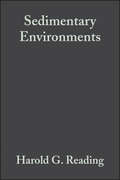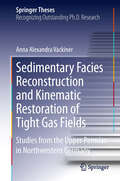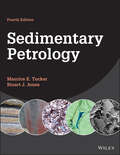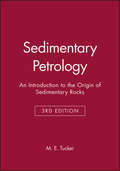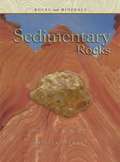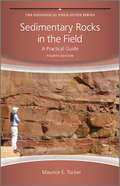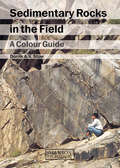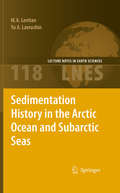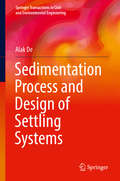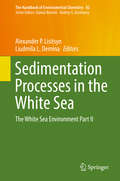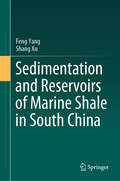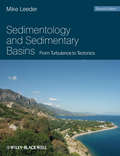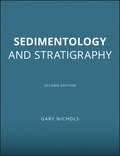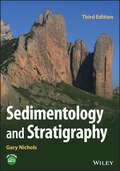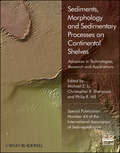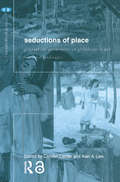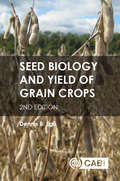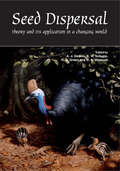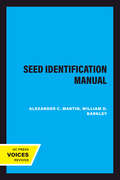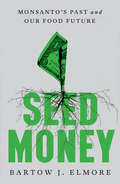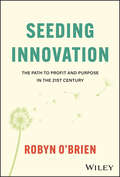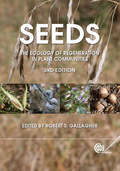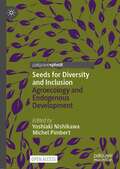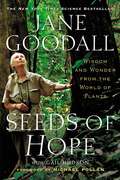- Table View
- List View
Sedimentary Environments: Processes, Facies and Stratigraphy
by H. G. ReadingSedimentary Environments is one of the most distinguished and influential textbooks in the earth sciences published in the last 20 years. The first and second editions both won universal praise and became classic works in sedimentology. Since the publication of the last edition, the study of sedimentary environments and facies has made great strides, with major advances in facies modelling, sequence stratigraphy and basin modelling. The 3rd edition of this classic text will likely set the benchmark even higher, and needless to say, will continue being the textbook of choice for sedimentology students. The latest edition of a classic text. Incorporates all the latest advances in dynamic stratigraphy. Will remain the textbook of choice for upper level undergraduate and graduate students in sedimentology.
Sedimentary Facies Reconstruction and Kinematic Restoration of Tight Gas Fields: Studies from the Upper Permian in Northwestern Germany
by Anna Alexandra VackinerThe thesis of Anna Alexandra Vackiner focuses on the geometric architecture and tectonic evolution of the Permian series, combining seismic interpretation (3D block), field studies in an analogue basin (Panamint Valley in California), as well as 2D restoration of representative cross sections through time in order to illustrate the complex interaction between multiphase extension, inversion and salt diapirism. It will be of major interest for exploration geologists involved in tectonically complex areas. - François Roure, August 2012 This thesis improves the understanding and localization of the Upper Rotliegend II tight gas reservoir rock facies. It provides insights into the detailed Upper Rotliegend II palaeo-topography and local tectonically induced sediment thickness changes prior to a multi-phase tectonic overprinting. The research presented in this study further focuses on the tectonically induced synsedimentary facies distribution in transtensional continental settings on the basis of a comparison with a modern field analogue, which enables a detailed analysis of the reservoir rock's distribution and its properties. The study is rounded off with an analysis of the influence of the multiphase tectonic overprinting on the mature Upper Rotliegend II reservoir rocks.
Sedimentary Petrology
by Maurice E. Tucker Stuart J. JonesAuthoritative, accessible, and updated introduction to sedimentary rocks for undergraduate students Sedimentary Petrology provides readers with a concise account of sedimentary rock composition, mineralogy, texture, structure, diagenesis, and depositional environments. The new edition of this classic text incorporates the many technological and analytical advances of the last decade, revealing exciting details of processes such as microbial precipitation, how microporosity is created within mudrocks, and the chemical composition of foraminifera deposits, which can be a key indicator for changing seawater temperature. This fourth edition offers a comprehensive update and expansion of the previous editions with a new set of illustrations, new references, and further reading. The new co-author Stuart Jones has brought his considerable expertise in clastic sedimentology to the rewritten chapters on sandstones and mudrocks. The addition of color images throughout the text will aid students immensely in their studies and petrographic fieldwork. Sample topics covered in Sedimentary Petrology include: Advances in modeling and programming to simulate depositional-diagenetic conditions and controls which support field-lab descriptions and interpretations Ocean acidification and the demise of coral reefs, and the role of the oceans in carbon capture and storage Sedimentary ironstones and iron-formations, sedimentary phosphate deposits, coal, oil shale and petroleum, and cherts and siliceous sediments Limestones, evaporites, volcaniclastic sediments, sandstones, conglomerates, breccias, and the effects of microplastics on marine organismsAimed at undergraduates in geology and earth science, Sedimentary Petrology is an excellent teaching and learning resource for introductory courses in sedimentary rocks.
Sedimentary Petrology: An Introduction to the Origin of Sedimentary Rocks (Third Edition)
by Maurice E. TuckerThe earlier editions of this book have been used by successive generations of students for more than 20 years, and it is the standard text on the subject in most British universities and many others throughout the world. The study of sediments and sedimentary rocks continues to be a core topic in the Earth Sciences and this book aims to provide a concise account of their composition, mineralogy, textures, structures, diagenesis and depositional environments. This latest edition is noteworthy for the inclusion of 16 plates with 54 colour photomicrographs of sedimentary rocks in thin-section. These bring sediments to life and show their beauty and colorful appearance down the microscope; they will aid the student enormously in laboratory petrographic work. The text has been revised where necessary and the reference and further reading lists brought up-to-date. New tables have been included to help undergraduates with rock and thin-section description and interpretation.
Sedimentary Rocks (Rocks and Minerals)
by Melissa StewartHow did the Grand Canyon get so deep? Do you know what kind of rocks erodes most quickly? What items in your classroom do you think are made from sedimentary rocks? Read Sedimentary Rocks to find the answers to these questions and many more. You'll also find a hands-on activity to try at home or at school, as well as a glossary of unfamiliar words, resources to help you locate additional information, and a useful index.
Sedimentary Rocks in the Field
by Maurice E. TuckerThis fourth edition builds on the success of previous editions and for the first time is produced in full colour throughout with improved photos and diagrams. It retains its popular pocket size and is an essential buy for all students working in the field.The text shows how sedimentary rocks are tackled in the field and has been written for all those with a geological background. It describes how the features of sedimentary rocks can be recorded in the field particularly through the construction of graphic logs. In succeeding chapters the various sedimentary rock types, textures and structures are discussed and shown how they can be described and measured in the field. There are expanded sections on trace fossils and volcaniclastics along with updated reference list. Finally a concluding section deals briefly with facies identification and points the ways towards facies interpretations, and the identification of sequences and cycles.Key Features:Full colour throughout with improved photos, figures and diagrams in a modern layout.Complete revision and update of best selling textbook which is part of the highly successful Field Guide series.Expanded sections on trace fossils and volcaniclastics along with updated reference list.Handy pocket size with laminated cover.Includes supplementary website with downloadable logging sheets for fieldwork activities.
Sedimentary Rocks in the Field: A Colour Guide
by Dorrik A.V. StowIdeas and concepts in sedimentology are changing rapidly but fundamental field work and data collection remain the basis of the science. This book is intended as a guide to the recognition and description of sedimentary rocks in the field. It aims to help the geologist know what to observe and record and how best to interpret this data. The emphasi
Sedimentation History in the Arctic Ocean and Subarctic Seas for the Last 130 kyr
by Yu A. Lavrushin M. A. LevitanThis book to be published in the series "Lecture Notes in Earth Sciences" concentrates on own results (mainly Levitan et al.) and literature data from more detailed multidisciplinary case studies from Arctic Ocean and Subarctic seas (Norwegian-Greenland Sea, Sea of Okhotsk, Bering Sea), not discussed in the other books. Another major difference is the discussion of geological-paleoecological aspects and land-ocean interaction, not included in the other books.
Sedimentation Process and Design of Settling Systems
by Alak DeThis book is designed to serve as a comprehensive source of information of sedimentation processes and design of settling systems, especially as applied to design of such systems in civil and environmental engineering. The book begins with an introduction to sedimentation as a whole and goes on to cover the development and details of various settling theories. The book traces the chronological developments of the comprehensive knowledge of settling studies and design of settling systems from 1889. A new concept of 'Velocity Profile Theorem', tool for settling problem analysis, has been employed to the analysis of the phenomenon of short circuiting. Complete theory of tube settling has been developed and its application to the computation of residual solids from the assorted solids through the same has been demonstrated. Experimental verification of the tube settling theory has also been presented. Field-oriented compatible design and operation methodology of settling system has been developed from the detailed study of a real settling system. New parameter for settling performance comparison appears to do justice for its purpose. Design methodology of high rate settling systems has been presented with worked out examples and the flexibility of control of operation has been shown. Lastly, along with the presentation of all the theories of 'Thickener Design' the same problem of thickening has been solved with all the methods to reveal the variation in the designed thickeners. The contents of this book will be useful to students, researchers, and professional engineers alike.
Sedimentation Processes in the White Sea: The White Sea Environment Part II (The Handbook of Environmental Chemistry #82)
by Liudmila L. Demina Alexander P. LisitsynThis book presents a new perspective on the sedimentation processes in the White Sea, based on a multidisciplinary research study conducted between 2001 and 2016. It provides a comprehensive review and discusses the latest research findings on the ecosystem of this sub-arctic zone.The topics addressed include suspended particulate matter as a main source and proxy of the sedimentation processes in the White Sea; vertical fluxes of dispersed sedimentary matter and absolute masses in the White Sea; and the development history and quaternary deposits of the modern White Sea basin. The authors closely examine the abundance and species composition of microalgae associations and the environmental conditions in the bottom sediments of the White Sea, namely, heavy metal accumulation and aliphatic and polycyclic aromatic hydrocarbons. The book ends contain a summary of the key conclusions and recommendations. Together with the companion volume Biogeochemistry of the Atmosphere, Ice and Water of the White Sea: The White Sea Environment Part I, it offers an essential source of information for postgraduate students, researchers, and stakeholders alike.
Sedimentation and Reservoirs of Marine Shale in South China
by Feng Yang Shang XuThis book systematically investigates the depositional process and reservoir characteristics of organic-rich shales, including (1) The types and development mechanisms of organic-rich shales under ancient ocean and climatic backgrounds. Schematic models are proposed to understand the organic matter enrichment and depletion in shale systems. (2) Microstructure and petrophysical properties. The general lithofacies are recognized and linked to the depositional setting and petrophysical properties. Full-scale pores and fractures are characterized using FE-SEM, gas adsorption, nano-CT and micro-CT scanning. (3) Brittle-ductile characteristics. Rock mechanical properties and in-situ stress are determined. The brittle-ductile transformation of shales is discussed. (4) Shale gas occurrence state and differential enrichment. Gas content and dynamic dissipation over geological time are evaluated using sorption experiments and numerical simulation. Shale gas enrichment model is developed to understand the gas differential accumulation in organic-rich shales. This book can be used for reference by researchers engaged in shale oil and gas geology in both academics and industry.
Sedimentology and Sedimentary Basins
by Mike R. LeederThe sedimentary record on Earth stretches back more than 4.3 billion years and is present in more abbreviated forms on companion planets of the Solar System, like Mars and Venus, and doubtless elsewhere. Reading such planetary archives correctly requires intimate knowledge of modern sedimentary processes acting within the framework provided by tectonics, climate and sea or lake level variations. The subject of sedimentology thus encompasses the origins, transport and deposition of mineral sediment on planetary surfaces.The author addresses the principles of the subject from the viewpoint of modern processes, emphasising a general science narrative approach in the main text, with quantitative background derived in enabling 'cookie' appendices. The book ends with an innovative chapter dealing with how sedimentology is currently informing a variety of cognate disciplines, from the timing and extent tectonic uplift to variations in palaeoclimate. Each chapter concludes with a detailed guide to key further reading leading to a large bibliography of over 2500 entries. The book is designed to reach an audience of senior undergraduate and graduate students and interested academic and industry professionals.
Sedimentology and Stratigraphy
by Gary NicholsThis fully revised and updated edition introduces the reader to sedimentology and stratigraphic principles, and provides tools for the interpretation of sediments and sedimentary rocks. The processes of formation, transport and deposition of sediment are considered and then applied to develop conceptual models for the full range of sedimentary environments, from deserts to deep seas and reefs to rivers.Different approaches to using stratigraphic principles to date and correlate strata are also considered, in order to provide a comprehensive introduction to all aspects of sedimentology and stratigraphy. The text and figures are designed to be accessible to anyone completely new to the subject, and all of the illustrative material is provided in an accompanying CD-ROM. High-resolution versions of these images can also be downloaded from the companion website for this book at:www.wiley.com/go/nicholssedimentology.
Sedimentology and Stratigraphy
by Gary NicholsSedimentology and Stratigraphy Comprehensive textbook on all aspects of sedimentology and stratigraphic principles Sedimentology and Stratigraphy introduces the reader to the subjects and provides tools for the interpretation of sediments and sedimentary rocks, covering the processes of formation, transport, and deposition of sediment and applying them to develop conceptual models for the full range of sedimentary environments, from deserts to deep seas and reefs to rivers. Different approaches to using stratigraphic principles to date and correlate strata are also considered to provide a comprehensive overview of all aspects of sedimentology and stratigraphy. The 3rd edition has been thoroughly revised and updated. The book is now divided into five sections, and the chapters on different depositional settings now provide distinct sections on modern processes and sedimentary rocks. The new edition also features a new set of diagrams and photographs in full colour. Key concepts introduced in Sedimentology and Stratigraphy include: The importance of changes in plant and animal life through time and the effects on characteristics of both marine and continental sedimentary environments The distinction between modern environments and what is preserved in the sedimentary record The role of changing climate, tectonic events and sediment supply in determining the characteristics of deposits in the stratigraphic record Written by a highly qualified author with abundant experience in the field, Sedimentology and Stratigraphy serves as a highly accessible resource for students of geology and related subjects who seek to understand the formation, characteristics, and importance of sedimentary rocks.
Sediments, Morphology and Sedimentary Processes on Continental Shelves
by Christopher R Sherwood Philip R Hill Michael Z LiThe application of multibeam and sediment transport measurement technologies and the adoption of multi-faceted research methodologies have greatly advanced our understanding of the sedimentary processes on continental shelves in the last decade.This book uniquely blends cutting-edge research and state-of-the art review articles that take stock of new advances in multibeam mapping and sediment transport technologies, spatial analysis and modelling, and the applications of these advances to the understanding of shelf sediments, morphodynamics, and sedimentary processes. Case studies are also presented to illustrate the utilization of seabed property and process knowledge in habitat mapping and ocean managementWith its mix of papers focusing on technological advances, integration of shelf morphology and processes, and the application of these advances to coastal and ocean management, this Special Publication volume will serve as a milestone reference for professional marine scientists and as advanced text for students in marine geology, sedimentology and oceanography.This book is part of the International Association of Sedimentologists (IAS) Special Publications.The Special Publications from the IAS are a set of thematic volumes edited by specialists on subjects of central interest to sedimentologists. Papers are reviewed and printed to the same high standards as those published in the journal Sedimentology and several of these volumes have become standard works of reference.
Seductions of Place: Geographical Perspectives on Globalization and Touristed Landscapes (Critical Geographies #Vol. 19)
by Alan A LewThe seductiveness of touristed landscapes is simultaneously local and global, as travelled places are formed and reworked by the activities of diverse, mobile people, in their desires to experience situated, sensuous qualities of difference. Cartier and Lew’s interesting and informative book explores contemporary issues in travel and tourism and human geography, and the complex cultural, political, and economic activities at stake in touristed landscapes as a result of globalization. This book assesses travel and tourism as simultaneously cultural and economic processes, through ideas about place seduction and the formation of landscapes. Throughout, examples are given from urban and environmental touristed landscapes, from major world cities to tropical islands, and chapter contributions include: an analysis of the representational character of landscape and the built environment historic constructions of place seduction the importance of class, racial, and gender dimensions of place how mobility and the seduction of place orient identity formation the environmental impacts of tourism economies. Broad in scope, this book is ideal for social scientists and humanists who are interested in contemporary debates about place studies, mobility, and the located realities of globalization.
Seed Biology and Yield of Grain Crops
by Dennis EgliThis new edition of an established title examines the determination of grain crop yield from a unique perspective, by concentrating on the influence of the seed itself. As the food supply for an expanding world population is based on grain crops harvested for their seeds, understanding the process of seed growth and its regulation is crucial to our efforts to increase production and meet the needs of that population. Yield of grain crops is determined by their assimilatory processes such as photosynthesis and the biosynthetic processes in the seed, which are partly regulated within the seed itself. Providing a timely update in this field and highlighting the impact of the seed on grain crop yields, this book: · Describes all aspects of seed growth and development, including environmental and genetic effects on growth rate and length of the filling period. · Discusses the role of the seed in determining the two main yield components: individual seed weight and number of seeds per unit area. · Uses the concepts and models that have been developed to understand crop management and yield improvement. Substantially updated with new research and further developments of the practical applications of the concepts explored, this book is essential reading for those concerned with seed science and crop yield, including agronomists, crop physiologists, plant breeders, and extension workers. It is also a valuable source of information for lecturers and graduate students of agronomy and plant physiology.
Seed Biology and Yield of Grain Crops, 2nd Edition
by Dennis B. EgliThis new edition of an established title examines the determination of grain crop yield from a unique perspective, by concentrating on the influence of the seed itself. As the food supply for an expanding world population is based on grain crops harvested for their seeds, understanding the process of seed growth and its regulation is crucial to our efforts to increase production and meet the needs of that population. Yield of grain crops is determined by their assimilatory processes such as photosynthesis and the biosynthetic processes in the seed, which are partly regulated within the seed itself. Providing a timely update in this field and highlighting the impact of the seed on grain crop yields, this book: #65533; Describes all aspects of seed growth and development, including environmental and genetic effects on growth rate and length of the filling period. #65533; Discusses the role of the seed in determining the two main yield components: individual seed weight and number of seeds per unit area. #65533; Uses the concepts and models that have been developed to understand crop management and yield improvement. Substantially updated with new research and further developments of the practical applications of the concepts explored, this book is essential reading for those concerned with seed science and crop yield, including agronomists, crop physiologists, plant breeders, and extension workers. It is also a valuable source of information for lecturers and graduate students of agronomy and plant physiology.
Seed Dispersal: Theory and Its Application in a Changing World
by Andrew J. Dennis Eugene W. Schupp Ronda J. Green David A. WestcottFresh concepts in the study of seed dispersal are spurring a host of exciting new answers, answers to old questions, new methods and approaches, and a reinvigoration of the field. Seed Dispersal: Theory and its Application in a Changing World present both recent advances and reviews of current knowledge, demonstrating the vigour and vibrancy of the field.
Seed Identification Manual
by Alexander C. Martin William D. BarkleyThis title is part of UC Press's Voices Revived program, which commemorates University of California Press’s mission to seek out and cultivate the brightest minds and give them voice, reach, and impact. Drawing on a backlist dating to 1893, Voices Revived makes high-quality, peer-reviewed scholarship accessible once again using print-on-demand technology. This title was originally published in 1961.This title is part of UC Press's Voices Revived program, which commemorates University of California Press’s mission to seek out and cultivate the brightest minds and give them voice, reach, and impact. Drawing on a backlist dating to 1893, Voices Revived</DIV
Seed Money: Monsanto's Past And Our Food Future
by Bartow J. ElmoreAn authoritative and eye-opening history that examines how Monsanto came to have outsized influence over our food system. Monsanto, a St. Louis chemical firm that became the world’s largest maker of genetically engineered seeds, merged with German pharma-biotech giant Bayer in 2018—but its Roundup Ready® seeds, introduced twenty-five years ago, are still reshaping the farms that feed us. When researchers found trace amounts of the firm’s blockbuster herbicide in breakfast cereal bowls, Monsanto faced public outcry. Award-winning historian Bartow J. Elmore shows how the Roundup story is just one of the troubling threads of Monsanto’s past, many told here and woven together for the first time. A company employee sitting on potentially explosive information who weighs risking everything to tell his story. A town whose residents are urged to avoid their basements because Monsanto’s radioactive waste laces their homes’ foundations. Factory workers who peel off layers of their skin before accepting cash bonuses to continue dirty jobs. An executive wrestling with the ethics of selling a profitable product he knew was toxic. Incorporating global fieldwork, interviews with company employees, and untapped corporate and government records, Elmore traces Monsanto’s astounding evolution from a scrappy chemical startup to a global agribusiness powerhouse. Monsanto used seed money derived from toxic products—including PCBs and Agent Orange—to build an agricultural empire, promising endless bounty through its genetically engineered technology. Skyrocketing sales of Monsanto’s new Roundup Ready system stunned even those in the seed trade, who marveled at the influx of cash and lavish incentives into their sleepy sector. But as new data emerges about the Roundup system, and as Bayer faces a tide of lawsuits over Monsanto products past and present, Elmore’s urgent history shows how our food future is still very much tethered to the company’s chemical past.
Seeding Innovation: The Path to Profit and Purpose in the 21st Century
by Robyn O'BrienBuild and grow a company ready for the next generation of consumers In Seeding Innovation: The Path to Profit and Purpose in the 21st Century, veteran entrepreneur, award winning author, global strategist, speaker, and Rice University Innovation and Entrepreneurship professor, Robyn O’Brien, delivers an insightful and data driven roadmap to authenticity and smart leadership in the face of accelerating technological, environmental, and social change. In the book, you’ll discover how to build resilience, authenticity, market share and purpose into your business plan and move beyond box-ticking, virtue signaling and one-dimensional metrics, in a way that strengthens your business model, enhances your bottom line, attracts investors, fortifies employee retention, and more.With her characteristic candor and attention to data and deep experience on the frontlines of industry change, Robyn explains how you can transform concepts like paradigm blindness, scarcity, imposter syndrome, rejection, and fear to build durable, lasting, and profitable businesses that integrate social and environmental principles, with courage and integrity to drive long term shareholder and stakeholder value.You’ll also discover how to: Develop a purpose-driven product line that holds strong appeal for new generations of consumers and avoids the ruthless practices associated with PR nightmares and externalized costs Build an iconic company that focuses on integrating meaningful change to inspire customers, investors, and employees and that eschews meaningless press releases and virtue signaling Overcome imposter syndrome and naysayers using the S.T.O.P. Protocol ™ Develop supportive scaffolding and a resilient mindset in order to leverage courage and gain market share Build boards (not echo chambers), why equity and governance matters, and how diversity is good for your bottom line Integrate authentic marketing and storytelling into your brand strategy to drive revenue and capture market share Avoid the dangers of silos, fundraising traps and toxic capital and build a model with value-aligned, informed investors. Spot greenwashing, gender washing, and carbon washing, and more importantly, how to avoid them within your own organization and drive change Address headlines around ESG and DEI metrics in order to meet the needs of asset managers and investors, build successful teams and integrate goals that are central to outperformance and higher returns Gen Z and the modern consumer are looking for companies with authenticity—they want transparency and purpose from brands that are future proofing for the planet they’re inheriting. With this changing consumer focus and mindset emerges an urgent need for emotionally intelligent leadership. Along with profitability, 21st century leaders must focus on environmental stewardship, equity and justice, employee retention, recruiting, collaboration, and emerging other key aspects of modern business.
Seeds
by Robert S GallagherThe 3rd edition of Seeds: The Ecology of Regeneration in Plant Communities highlights the many advances in the field of seed ecology and its relationship to plant community dynamics that have taken place in recent years. The new edition also features chapters on seed development and morphology, seed chemical ecology, implications of climate change on regeneration by seed, and the functional role of seed banks in agricultural and natural ecosystems. The book is aimed at advanced level students and researchers in the fields of seed science, seed ecology and plant ecology.
Seeds for Diversity and Inclusion: Agroecology and Endogenous Development
by Yoshiaki Nishikawa Michel PimbertThis open access book will contribute to a more nuanced debate around seed system resilience that goes beyond the dominant dichotomous conceptualization of seed governance often characterized as traditional vs modern, subsistence vs commercial, or local vs global. While reflecting on the expanding oligopoly in the current seed system, the authors argue that such classifications limit our ability to critically reflect on and acknowledge the diverse approaches through which seed governance is practiced around the world, at various scales, creating a mosaic of dynamic complementarities and autonomies. The authors also highlight the importance of this much needed dialogue through case studies of seed governance approaches and practices found in and around Japan.
Seeds of Hope
by Jane Goodall Gail HudsonRenowned naturalist and bestselling author Jane Goodall examines the critical role that trees and plants play in our world. In her wise and elegant new book, Jane Goodall blends her experience in nature with her enthusiasm for botany to give readers a deeper understanding of the world around us.Long before her work with chimpanzees, Goodall's passion for the natural world sprouted in the backyard of her childhood home in England, where she climbed her beech tree and made elderberry wine with her grandmother. The garden her family began then, she continues to enjoy today. SEEDS OF HOPE takes us from England to Goodall's home-away-from-home in Africa, deep inside the Gombe forest, where she and the chimpanzees are enchanted by the fig and plum trees they encounter. She introduces us to botanists around the world, as well as places where hope for plants can be found, such as The Millennium Seed Bank, where one billion seeds are preserved. She shows us the secret world of plants with all their mysteries and potential for healing our bodies as well as Planet Earth.Looking at the world as an adventurer, scientist, and devotee of sustainable foods and gardening-and setting forth simple goals we can all take to protect the plants around us-Jane Goodall delivers an enlightening story of the wonders we can find in our own backyards.
